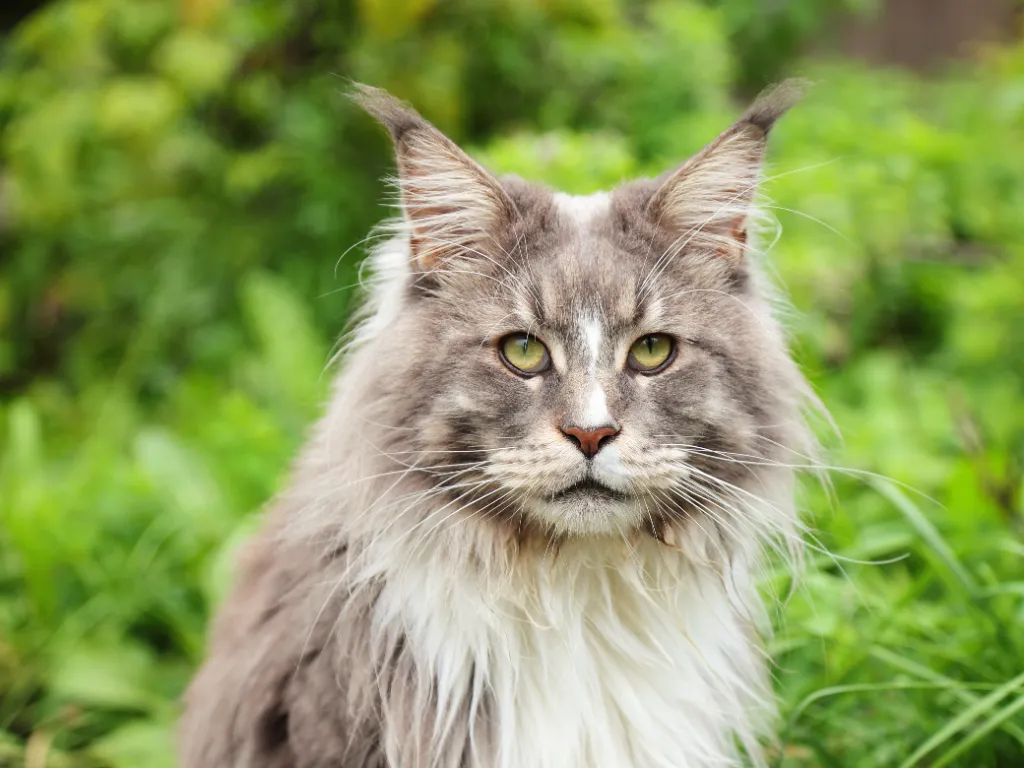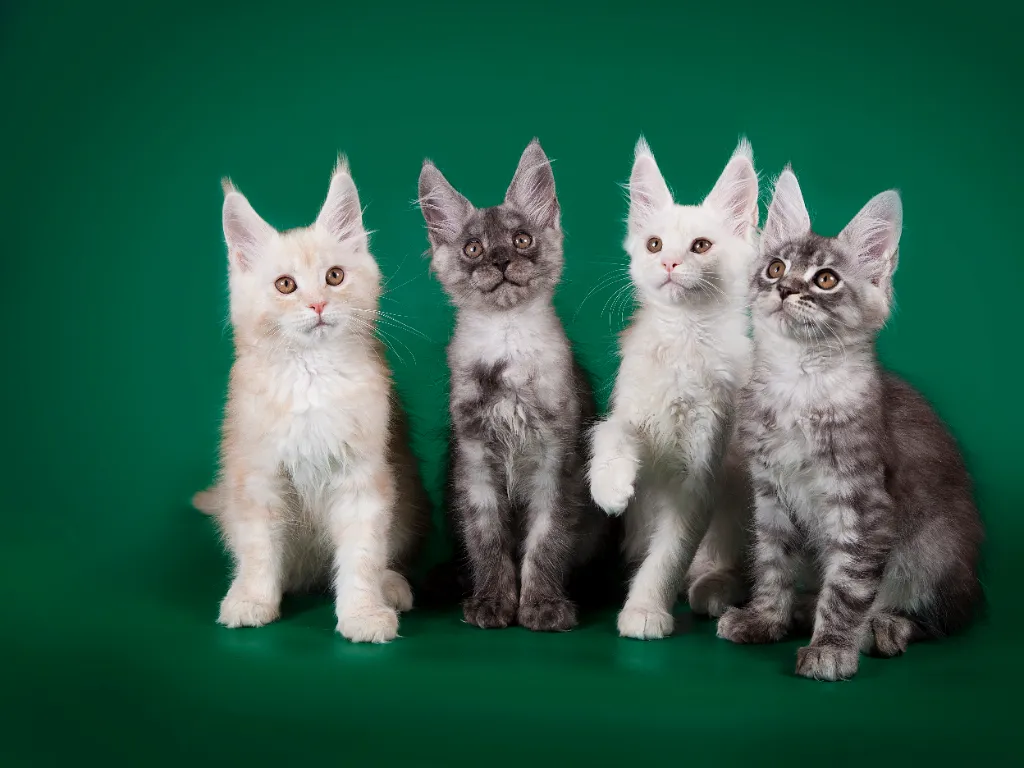The enchanting Maine Coon cat breed has captured the hearts of many, quickly becoming a favorite among cat enthusiasts for its remarkable personality, friendly nature, and stunning physical features.
Yet, for those among us grappling with allergies, one critical question often surfaces: “Are Maine Coon cats hypoallergenic?”
This article is set to clear the air on this frequently asked question, debunking myths and shedding light on the truth. Whether you’re already sharing your home with a Maine Coon or contemplating adding one to your family, this guide is designed to assist you in fostering a comfortable and joyful living space for everyone involved.
Join us as we explore effective strategies for managing allergies without compromising on the joy these magnificent cats bring into our lives.
About The Maine Coon Breed
The Maine Coon cat has become a popular breed among cat lovers. These captivating felines are known for their remarkable size, friendly demeanor, and distinctive physical features.
Maine Coons stand out for their large size, tufted ears, bushy tails, and luxurious coats that come in an array of colors and patterns. Renowned for their sociable nature, these gentle giants form strong bonds with their human companions.
Their playful and affectionate personalities, coupled with their adaptability to various living situations, further cement their place as a popular breed.
Cat lovers are drawn to Maine Coons not only for their striking appearance but also for their intelligence and interactive behavior. These cats often exhibit dog-like traits, including fetching toys and even walking on leashes.
Their amiable disposition makes them excellent companions for families, singles, and seniors alike. Additionally, their history as skilled hunters lends them an air of mystery and respect, appealing to those who appreciate the blend of domesticity and wild spirit.
[Editors note: Looking for more information about Maine Coon cats? Check out our complete Maine Coon breed information and care guide here!]
Are Maine Coon Cats Hypoallergenic?
Maine Coon cats are such unique and endearing cats that they even tempt people with allergies to cats to consider getting one. Some sources report that this breed is an excellent choice for those with cat allergies, since they shed less than some breeds and are therefore hypoallergenic.
Despite this common misconception, we are sorry to have to tell you – Maine coons are NOT hypoallergenic!
Maine Coons produce the same allergenic proteins that other cats do, which are the same substances found in other cat breeds that often provoke allergies.
Therefore, individuals prone to cat allergies might still experience symptoms when in contact with Maine Coon cats, such as sneezing, runny nose, itchy eyes, or worse, depending on how severe their allergies are.

What Are Cat Allergies?
Cat allergies are immune responses triggered by proteins found in a cat’s skin cells, saliva, and urine. An allergic response is an exaggerated reaction of the immune system to substances that are usually harmless, known as allergens.
When an individual with allergies encounters an allergen, their immune system recognizes it as a potential hazard and triggers the production of specific antibodies, predominantly immunoglobulin E (IgE), in response.
Upon subsequent exposure to the same allergen, these IgE antibodies trigger the release of histamines and other chemicals from immune cells, leading to allergic symptoms.
Histamines and other mediators cause a range of effects, such as inflammation, increased mucus production, and dilation of blood vessels. These responses contribute to the various symptoms associated with allergies.
Allergic responses can vary widely in severity, from mild discomfort to life-threatening reactions. Allergies can be triggered by a diverse array of substances, including pollen, dust mites, animal dander, certain foods, insect venom, and medications.
Management typically involves avoiding allergens, using antihistamines or other medications to alleviate symptoms, and, in some cases, undergoing allergy immunotherapy to desensitize the immune system to specific allergens over time.
Cat Allergy Symptoms
Cat allergy symptoms typically manifest as a range of discomforting reactions when a person comes into contact with allergens produced by a cat. These symptoms can vary in intensity and may include:
- Sneezing and Runny Nose: Allergens can irritate the nasal passages, leading to frequent sneezing and a runny or congested nose.
- Itchy, Watery Eyes: Exposure to cat allergens can cause itching and redness in the eyes, along with excessive tearing.
- Skin Reactions: Skin may become itchy, red, or develop hives upon contact with allergens. Scratching can exacerbate these symptoms.
- Coughing and Wheezing: Inhaling cat allergens can lead to coughing and wheezing, especially in individuals with respiratory sensitivity.
- Shortness of Breath: Severe allergic reactions may result in difficulty breathing, chest tightness, or shortness of breath.
- Asthma Exacerbation: People with asthma may experience worsened symptoms, including increased coughing, wheezing, and chest tightness, when exposed to cat allergens.
- Skin Contact Reactions: Direct contact with a cat or its fur may cause itching, redness, and hives on the skin.
- Generalized Symptoms: Allergic reactions can sometimes lead to more generalized symptoms, such as fatigue, headaches, and irritability.
It’s important to note that symptoms can vary from person to person and may range from mild to severe. Individuals with a history of allergies, asthma, or other respiratory conditions are more likely to experience pronounced cat allergy symptoms.
What Are The Main Cat Allergens?
The main cat allergens are specific proteins found in a cat’s skin cells, saliva, and urine that can trigger allergic reactions in susceptible individuals. These allergens are primarily responsible for causing symptoms in people with cat allergies. The two primary cat allergens are:
Fel d 1: This allergen is considered the main culprit in allergies to cats. It is primarily produced in a cat’s salivary and sebaceous (skin oil) glands, and is also found in the urine. Fel d 1 is a potent allergen and is responsible for the majority of cat-related allergic reactions.
Fel d 4: This allergen is found in a cat’s skin cells, particularly in the epithelial cells found in the skin’s outer layer. These skin cells can become airborne when shed and can contribute to allergic reactions when they come into contact with sensitive individuals. It is also found in the saliva.
Both Fel d 1 and Fel d 4 are highly stable and lightweight, allowing them to remain suspended in the air and settle on surfaces for extended periods. This persistence makes it easy for these allergens to become airborne and be inhaled, even if the cat is not physically present.
While these are the primary cat allergens, other proteins and particles present in a cat’s environment, such as cat urine proteins and microscopic particles of dried saliva and skin cells (cat dander), can also contribute to allergic responses in some individuals.

The Role Of Cat’s Saliva In Allergies
Cat saliva plays a significant role in causing allergies, particularly in individuals who are sensitive to cat allergens. Both Fel d 1 and Fel d 4 are produced in the salivary glands of cats and is transferred to their fur when they groom themselves.
As cats lick their fur to clean themselves, the proteins become deposited on their fur and skin. With further grooming and the cat’s movements, the allergen-coated fur can become airborne and settle on surfaces within the environment.
This makes it easy for these allergens to become dispersed in the air, inhaled, and come into contact with individuals who may be allergic. Once inhaled or touched, these allergens can trigger allergic reactions in susceptible individuals.
Does Cat’s Fur Cause Allergies?
Cat fur can contribute to allergies, but it is not the fur itself that is the primary source of allergic reactions. Instead, the allergens present in a cat’s fur and skin cells are the main culprits.
The two primary cat allergens, Fel d 1 and Fel d 4, are often found in the skin cells, saliva, and sebaceous glands of cats. When cats groom themselves, these allergens become deposited on their fur and skin.
As a result, cat fur can carry and disperse these allergens into the environment. When the fur becomes airborne or settles on surfaces, it can come into contact with sensitive individuals and trigger allergic reactions.
Inhaling or touching surfaces contaminated with cat allergens can lead to symptoms such as sneezing, runny nose, itchy eyes, and skin irritation.
While the fur itself is not the direct cause of allergies, it can act as a carrier for the allergens. Long fur or thick fur provides even more surface area for the allergens to stick to, making it seem like long hair cats are worse for allergies than short hair cats.
Do Hypoallergenic Cats Exist?
Hypoallergenic refers to substances or organisms that are less likely to trigger allergic reactions in sensitive individuals.
In the context of cats, it implies that certain breeds may produce fewer allergens or have allergens that are less potent, potentially making them more tolerable for people prone to allergies.
However, it’s important to note that no cat can be truly hypoallergenic, as all cats produce allergenic proteins such as Fel d 1. While some cats might have lower levels of these allergens, they cannot eliminate them entirely.
Certain cat breeds, like the Siberian and Balinese, have been reported by some individuals to cause fewer allergy symptoms.
In fact, researchers have discovered genetic mutations in Siberian cats that affect the production of the Fel d 1 protein. This finding suggests that Siberian cats may have lower levels of this protein compared to other cat breeds, and may be the closest thing to a hypoallergenic breed you can find.
These breeds might shed fewer skin cells or produce less potent allergens, potentially making them more manageable for those with allergies. However, individual reactions can vary widely, and it’s important for allergic individuals to spend time with a cat from the specific breed they are considering to assess their personal sensitivity.
In summary, while hypoallergenic cat breeds may produce fewer allergens, no cat can guarantee an entirely allergy-free experience.
If you have allergies, it’s advisable to consult with an allergist before getting a Maine coon or any other cat and to take measures to reduce allergen exposure in your living environment.
Regular Grooming and Air Purifiers: The Best Way To Reduce Environmental Allergens
Regular grooming and air purifiers can play significant roles in reducing cat environmental allergens, helping to create a more comfortable living environment for individuals who are sensitive to cat allergens.
Regular Grooming
Regular grooming of your cat can help minimize the amount of loose fur that can become airborne and spread allergens throughout your home. There will also be less dander (skin flakes), which is of further benefit.
Grooming practices may include brushing your cat’s fur to remove loose hair and dander, wiping them down with a damp cloth to catch allergens, and bathing them occasionally using cat-friendly shampoos. This helps reduce the overall allergen load in your home and on your cat’s fur.
Air Purifiers
Air purifiers equipped with HEPA (High Efficiency Particulate Air) filters can effectively capture and remove airborne allergens, including those from cat dander and fur.
These filters can trap even the smallest allergen particles, improving indoor air quality and reducing the presence of allergens in the environment. Placing air purifiers in key areas of your home, such as bedrooms and living spaces, can help create allergy-friendly zones.
By combining these strategies, you can significantly reduce the amount of allergens in your living space. It’s important to note that while these measures can help alleviate allergy symptoms, they may not completely eliminate allergic reactions, especially in individuals with severe allergies.

8 Additional Steps For Reducing Cat Allergens Around Your Home
In addition to regular grooming and using air purifiers, there are several other effective measures you can take to further reduce cat allergens in your home:
- Frequent Cleaning: Regular cleaning of your home is essential to minimize allergen buildup. Vacuum your floors, carpets, and upholstery using a vacuum cleaner equipped with a HEPA filter. This helps trap allergens and prevents them from becoming airborne. Use a damp cloth or mop to wipe down surfaces and remove settled allergens.
- Wash Bedding and Fabrics: Wash your cat’s bedding, as well as your own, in hot water regularly to remove allergens. Use hypoallergenic covers for mattresses and pillows. Curtains, cushions, and other fabric-covered items should also be cleaned frequently.
- Designated Cat-Free Zones: Establish specific areas of your home where your cat is not allowed, especially in bedrooms and other areas where you spend a lot of time. This can create allergen-free spaces that provide relief from symptoms.
- Air Circulation and Ventilation: Ensure proper air circulation by opening windows and using fans to reduce allergen concentration indoors. Improved ventilation helps in removing allergens and bringing in fresh air.
- Allergen-Blocking Products: Consider using allergen-blocking products such as sprays or wipes that can neutralize or reduce allergens on surfaces.
- High-Quality Filters: Install high-quality furnace and air conditioning filters designed to capture allergens. Change these filters regularly according to the manufacturer’s recommendations.
- Minimize Soft Surfaces: Opt for easy-to-clean furnishings with minimal upholstery and decorative items. Hard surfaces are easier to wipe down and less likely to trap allergens.
- Personal Hygiene: Wash your hands and change your clothes after interacting with your cat. This prevents the transfer of allergens to different areas of your home.
By combining these measures with regular grooming and air purifiers, you can create a more allergen-friendly environment and reduce the impact of cat allergens on your health and comfort.
Conclusion
The Maine Coon cat has rightfully earned its place as a beloved and popular breed, captivating cat lovers with its distinctive charm, friendly disposition, and notable physical attributes.
While the allure of hypoallergenic qualities may not hold true for Maine Coons, a deeper understanding of cat allergies, their triggers, and practical strategies for allergen reduction can empower individuals to make informed decisions about their feline companions.
By embracing measures such as regular grooming, air purifiers, and diligent cleaning practices, cat enthusiasts can create a more comfortable and harmonious living environment for both themselves and their cherished Maine Coon companions.
To create the most effective allergy management plan, consider consulting an allergist and implementing a comprehensive approach that includes grooming, air purification, cleaning, and other allergen-reduction strategies.
Doing so will help create a healthier and more enjoyable living environment for you and your Maine Coon.
Disclaimer: The information provided in this article is not a substitute for professional medical advice. If you have health concerns or suspect allergies, consult a qualified healthcare provider
Sources


